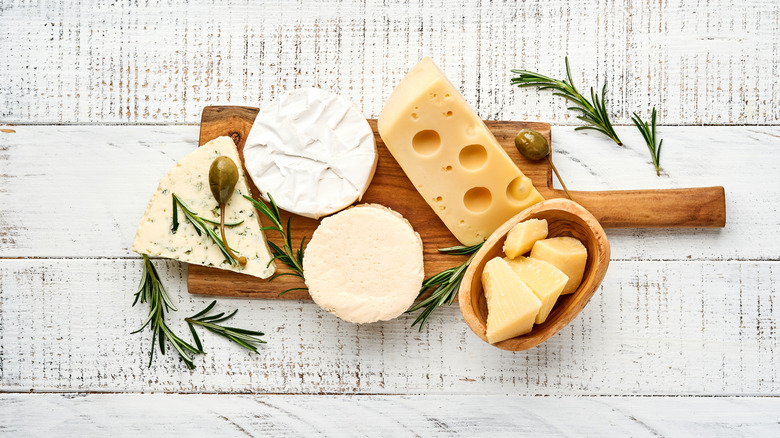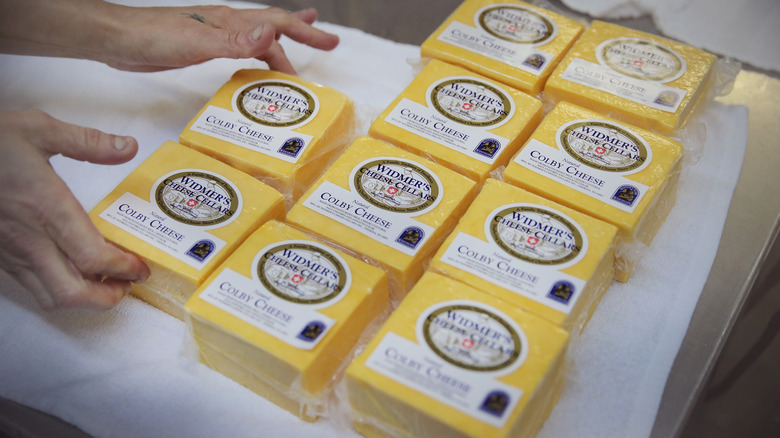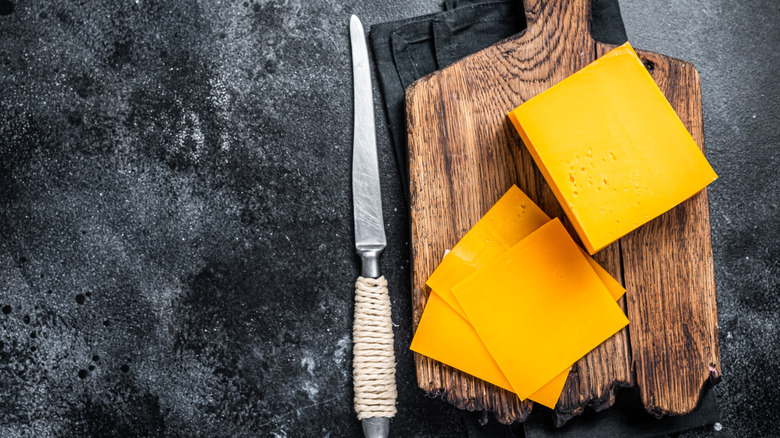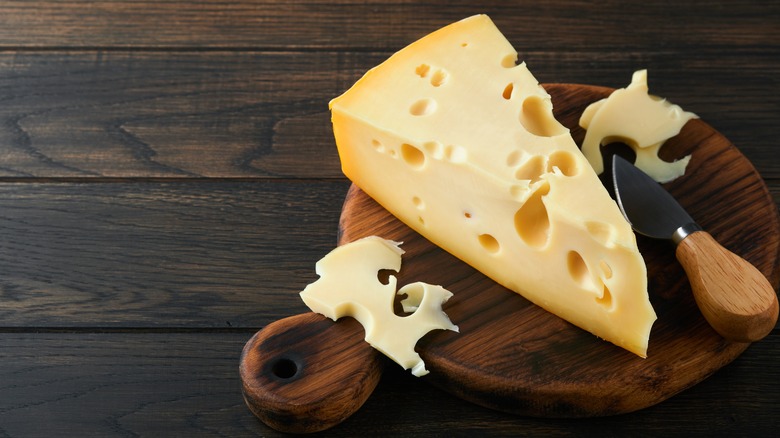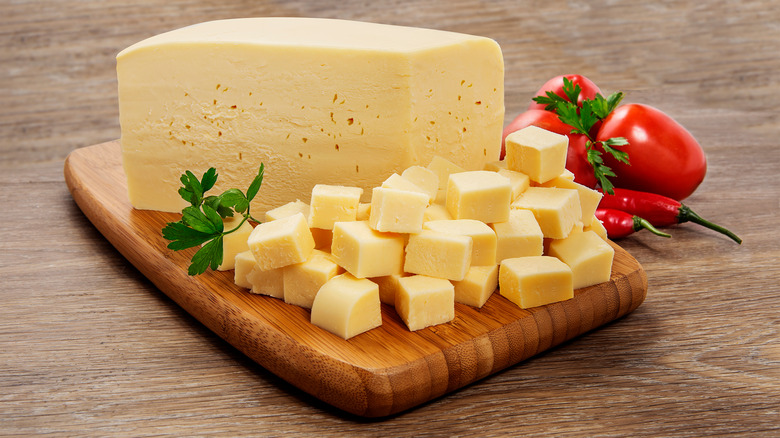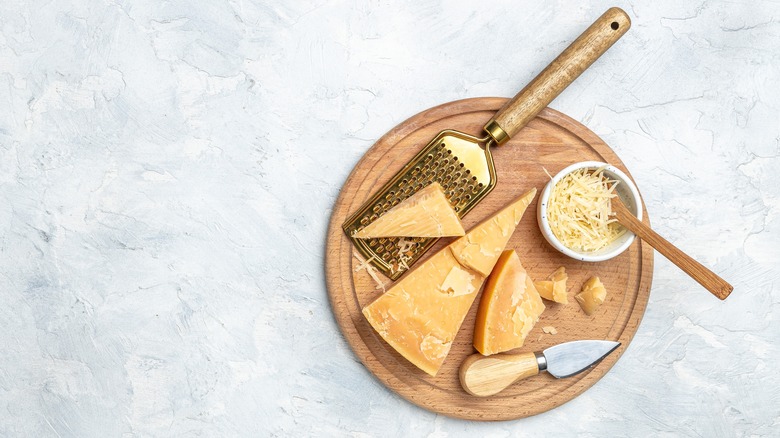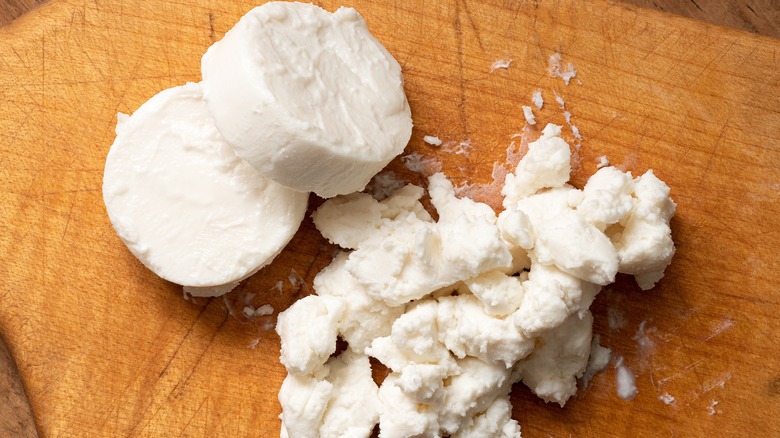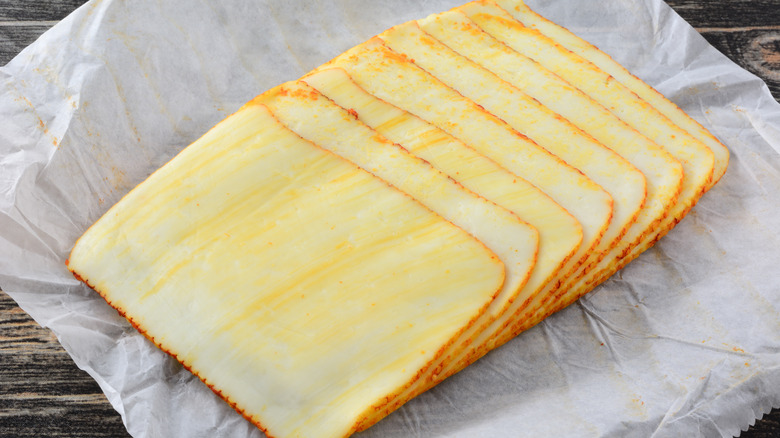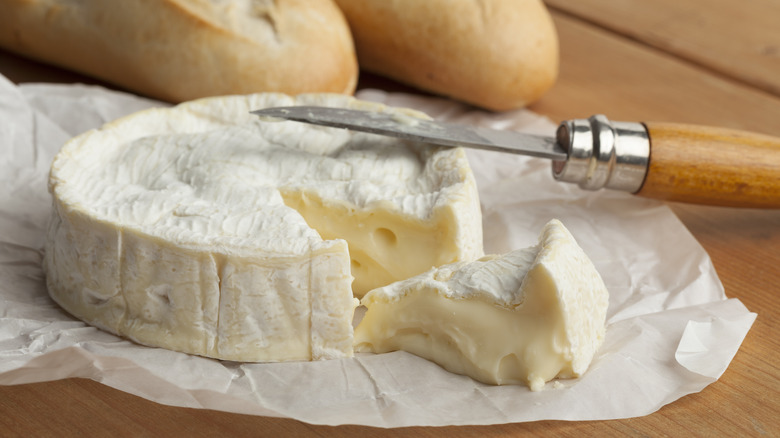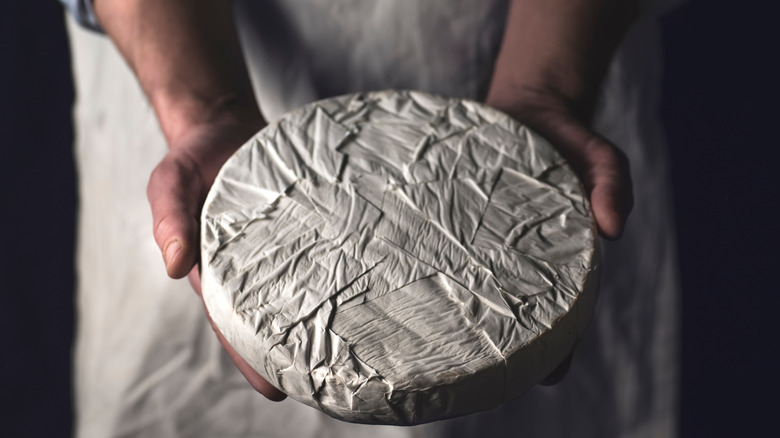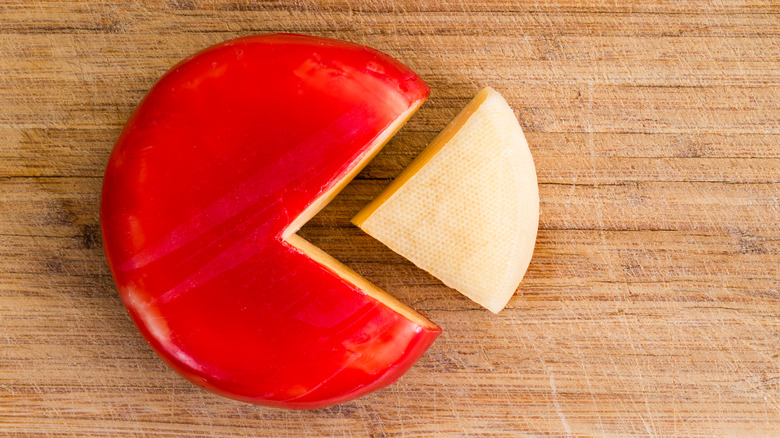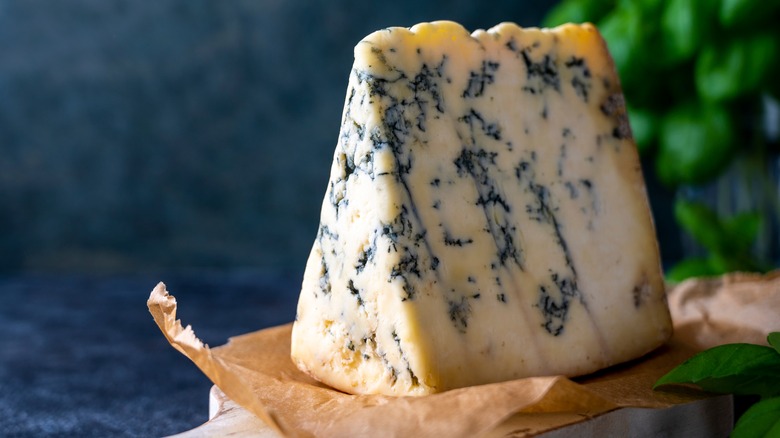13 Types Of Cheese That Are Safe For Lactose Intolerance
Lactose-intolerant cheese lovers everywhere rejoice! Despite common misconceptions, lactose intolerance does not necessarily mean you must entirely cut cheese out of your diet. Several types of cheese contain little to no lactose. A general guideline is that hard and aged cheeses are lower in lactose than cheeses that are soft and fresh, but we've done the research to take away some of the guesswork.
There are two common ways to measure lactose levels in cheese: grams per serving and percentages when you are searching for a cheese that is right for you. According to the U.S. Department of Health and Human Services, most lactose intolerant people can consume 12 grams of lactose in a serving, which is equivalent to 1 cup of milk. When lactose amounts are listed in percentages, it is referring to the percent of lactose by weight, correlating to how many grams of lactose would be found in 100 grams of that dairy product, as shown on Lacteeze.
Keep in mind, there's no hard rule that applies to everyone, so be mindful of what works for you and that you overdo it! As long as average-sized servings of low-lactose cheeses are consumed, lactose-intolerant individuals are free to welcome the following cheesy goodness back into their diets.
Colby cheese
Colby cheese, like cheddar, is a solid yellow/orange cheese. According to Wisconsin Cheese, Colby cheese was created in Colby, Wisconsin, by Joseph Steinwand, a cheddar maker who was experimenting to see how changes to the cheddar-making process would change the taste and texture of the resulting cheese. To make Colby cheese, the site says that the followed the normal cheddar-making process, but then washed his cheese curds in cold water, pressed them, and aged them anywhere from one to three months; this made it less acidic and, therefore, milder and sweeter than a traditional cheddar would be. A regular Colby is not to be confused with Colby Jack, which is a marbled cheese made by combining bits of Colby cheese and bits of Monterey Jack cheese.
Because Colby is a hard cheese and an aged cheese, it naturally has very little lactose in it. While couldn't find specifics on the exact amount of lactose in pure Colby cheese, it contains a minimal amount of lactose, which is washed away when the cheese curds are rinsed, and the overall content continues to drop during the months that it sits aging.
Cheddar cheese
Whether white or yellow, sharp or mild, cheddar cheese is a staple of the cheese world. From grilled cheese and mac and cheese to soups and omelets, cheddar cheese can be found in countless delicious dishes. Some may say it's basic and maybe even too simple, while others maintain that its wide accessibility and popularity are for a good reason.
One thing you may not know about cheddar cheese is that the name comes from a village in England where it was first created when a milkmaid left milk in a cave and came back to find it partially solidified. However, the cheddar cheese we eat today does not have to come from Cheddar at all; in fact, it is often produced in the United States. Because there is no strict definition of what makes cheddar cheese "cheddar," its variations are usually described using color and sharpness indicators, with sharpness being far more important for determining the taste. Generally, the sharper a cheddar is described to be, the longer it has aged and the stronger its taste will be.
Whether sharp or mild, all cheddar cheese has relatively low levels of lactose, and 1 ounce of sharp cheddar cheese contains about 0.4 to 0.6 grams of lactose (via UpToDate). In contrast to one cup of milk, cheddar cheese is clearly better suited for someone with lactose intolerance.
Swiss cheese
When you think of swiss, you probably think of a slice or chunk of cheese that is white in color with many holes throughout it. Of course, this is not the only type of cheese that comes from Switzerland. Other popular types of cheese, such as gruyère, also originate from Switzerland but are not referred to as "swiss cheese" in the United States. The type of cheese that is labeled as "swiss cheese" is actually an American take on a type of cheese from Switzerland called emmental. Swiss cheese came to the U.S. when Swiss immigrants tried to recreate their beloved emmental as similarly as possible in their new homeland. Swiss cheese produced in America is very similar to emmental but is usually a bit milder in flavor.
Swiss cheese, like many of the cheeses on this list, is an aged cheese with only 0.04 grams per 40 grams, which makes it great for lactose-intolerant individuals.
Mozzarella
Mozzarella cheese: creamy, delicious, and a staple for making pizza and other Italian dishes. Mozzarella may be well-loved, but can lactose-intolerant people add it to their list of safe foods to consume? The answer to that question is actually not simple enough to make a broad statement. Mozzarella cheese comes in many forms: logs, slices, blocks, pearls, and shreds, to name a few. Each of these forms of mozzarella has actually been aged for different timeframes, making their lactose contents wildly different.
According to SFGate, fresh mozzarella, which often comes in log or pearl form, is (as the name implies) fresh, meaning that it still contains quite a bit of lactose. While some of the lactose has already been washed away in the cheese-making process, making it contain less lactose than milk, it's likely not enough to be deemed safe for lactose-intolerant people. However, SFGate reports that hard mozzarella, which is often found in block or shredded form, ferments for about 2 weeks, lowering its lactose content. This fermentation is also what contributes to its firmness. So, for those with lactose intolerance who want to eat mozzarella cheese, be sure to look for mozzarella in firm block or shred form, rather than in fresh logs or pearls. While types of mozzarella can vary in lactose, it generally contains less than one gram of lactose per ounce (per SFGate).
Monterey Jack
Monterey Jack is a mild and melty cheese often used in quesadillas, burritos, casseroles, and more. Its meltiness even makes it a great addition to a gooey and delicious mac and cheese. But how does it affect your body when you eat it?
According to the USDA, a 28-gram serving of Monterey Jack cheese contains 12 percent of your daily recommended protein intake and 20 percent of your daily recommended calcium intake, so it can be a great way to meet your intake goals for those nutrients as part of your balanced diet. While we don't have specifics on the exact amount of lactose in Monterey Jack, USDA reveals that Monterey Jack contains about one gram of carbohydrates in a 28-gram serving. Because lactose is a type of carbohydrate, this means there cannot be more than around 3.5 grams of lactose in a 100-gram serving of Monterey Jack. Most likely, there is far less than that, because lactose is not the only type of carbohydrate found in cheese. This means that you don't have to miss out on a tasty calcium and protein source because of lactose intolerance.
Parmesan cheese
Whether you're sprinkling it on pasta and meatballs or a Caesar salad, you can't go wrong with parmesan cheese to add salty, crumbly goodness to your meals. Luckily for those with lactose intolerance, it can also be very low in lactose. According to Dark Cheese, the amount of lactose in parmesan cheese can vary according to the specific process of how each wheel is made. Since parmesan is a hard cheese that has usually aged for quite a bit of time, most parmesan on the market has lost a lot of lactose during the production process. This makes it a pretty reliable bet for those with lactose intolerance.
However, parmesan can still technically contain anywhere from 0.01 to over 5 percent lactose depending on aging, per Dark Cheese. But, fear not, in the United States specifically, parmesan is legally required to be aged for at least 10 months. Longer aging brings down the lactose level to about 1 to 3 percent (or 1 to 3 grams per 100-gram serving) — a safe range for those who are lactose intolerant. Any parmesan cheese aged for longer than that will contain even less lactose, so keep an eye out for the longest-aged parmesan you can find at the grocery store!
Goat cheese
Hard, aged cheeses are generally much lower in lactose than soft, fresh cheeses, therefore making them the best options for those with lactose intolerance. But, what if you want a creamy, spreadable cheese to enjoy without irritation? Then goat cheese, often also labeled as chèvre, might be a great solution for you.
According to Healthline, goat's milk starts out with only 4.2% lactose, while cow's milk starts out with about 5% lactose. Therefore, although goat's milk likely still has too much content for a lactose-intolerant person to consume without issue on its own, it is already starting out at a lower level. But, as with all cheeses, a great deal of lactose gets washed away during the transformation process from milk to cheese.
Because goat's milk starts out with less lactose, it doesn't need to be as hard or as aged as cow's milk cheeses do to reach a digestible level of lactose, making chèvre one of the few spreadable low-lactose cheese options. Additionally, some individuals who have trouble digesting dairy may struggle with an allergy to cow's milk in addition to lactose intolerance, making goat cheese one of the few cheese options that is a safer bet.
Muenster cheese
Muenster cheese is a delicious and melty cheese that can have a broad range of flavors from mild to strong depending on how it is processed and aged. According to Cheese.com, muenster was created as an American take on a French cheese called Munster, but it is generally milder and aged for less time than Munster cheese would. Muenster is a great cheese of choice for any situation where melting is required, such as inside a grilled cheese, folded into mac and cheese, or even sprinkled on pizza. It's also known to pair well with beer.
All muenster cheese is extremely low in lactose, with lactose levels ranging from 0 to 1.1 percent. This range is lower than most cheeses, even other cheeses that are determined to be generally safe for those who are lactose intolerant, like parmesan, which has a range of 0 to 3.2 percent. This makes muenster a perfect go-to choice for someone with lactose intolerance.
Camembert
While most soft cheeses contain too much lactose to be safe for lactose-intolerant people to consume, soft-ripened cheeses like camembert are a great exception due to their aging process, which reduces the amount of lactose inside. Camembert dates all the way back to 18th century France and has been quite popular ever since. According to Normandy Tourism, camembert was actually created by accident during the French Revolution when a farmer's wife incorrectly followed directions on how to make another popular French cheese, brie, and ended up with a more pungent result.
Camembert has a white rind with a creamy paste inside, and a flavor profile that is buttery, fruity, mildly tangy, and earthy all at once. Camembert cheese falls in the 0 to 1.8 percent lactose range, therefore making it safe for those with lactose intolerance to consume in normal quantities. This is another great option for those with lactose intolerance who do not want to be limited to consuming only hard cheeses.
Brie
Brie is another soft-ripened French cheese, with close ties to camembert. While the exact date and location of the invention of brie are up for debate, it gained a great deal of popularity in the eighth century thanks to French Emperor Charlemagne. Like many things, once brie had the approval of royalty, the rest of the population developed a fondness for it as well that lasted far beyond his reign. According to Old Europe Cheese, in 1815, the Congress of Vienna even held a contest for "the best cheese in the world," of which brie was the winner, referred to as "the king of cheese."
Brie has a very similar flavor profile to camembert and has a similar appearance as well, with a white bloomy rind and a creamy paste inside. Brie's lactose levels range from 0 to 2 percent, making them safe for normal consumption by those who are lactose intolerant.
Gouda
Gouda is a Dutch cheese, named after the town that it originates from. Gouda is so popular that it even accounts for half of the cheese that is produced in the entirety of Holland. In addition to being both popular and delicious, authentic Dutch gouda is also a particularly great source of vitamin K, a vitamin that can provide health benefits in a variety of ways, from promoting heart, skin, and bone health to reducing the risk of certain cancers (via Real Food RN).
Gouda is a semi-soft cheese that often has caramel or smoky flavor notes, with a waxy red or brown rind, depending on if it has been smoked. Despite gouda being classified as a semi-soft cheese, its center falls towards the firmer end of the semi-soft spectrum and is certainly much firmer than other semi-soft cheeses like brie or camembert. While gouda is a semi-soft cheese, it is usually aged anywhere from three months to over five years. This aging process therefore lowers the lactose content of gouda significantly, making it safe for lactose-intolerant people to enjoy. According to Old Europe Cheese, gouda has a lactose range of 0 to 2.2 percent, which falls within the generally acceptable range for those with lactose intolerance.
Blue cheese
Blue cheese is widely known for being very strong in flavor and has a reputation for being an acquired taste. This is mostly due to the blue or green streaks running through it that give it its name, which are made of mold. The idea of eating mold naturally makes some people pause and question, however, this mold is completely unlike the mold on a shower curtain or a month-old loaf of bread in that it is completely safe for human consumption.
There are also many different types of blue cheese, including creamy stilton, spicy or sweet gorgonzola, and pungent Roquefort. The rich, strong flavor that blue cheese brings is perfect for a wide variety of recipes, from making dip for buffalo wings for game day to creating tasty fresh salads with pear and mint. Blue cheese pairings can be salty, spicy, sweet, or anything in between.
Most types of blue cheese are also very low in lactose. For example, a study published in Nutrafoods tested 26 different samples of gorgonzola cheese for lactose content and only one registered as containing lactose. Even the gorgonzola that was detected to have lactose contained only 0.063 grams in a 100-gram serving, which is well within the safe range for lactose-intolerant individuals. Because blue cheese has such a range of flavor combinations, it makes a great versatile cheese group for those who are lactose intolerant to rely on.
Feta cheese
There's no doubt that feta is a classic, well-loved cheese. Its crumbly texture and tangy, salty taste pair well with a wide variety of recipes. From fresh Greek salads to creamy baked pasta recipes, feta is at home in hot dishes, cold dishes, starters, and main dishes alike.
However, there are also many other reasons why you should be eating feta cheese. In addition to being low-calorie and delicious, feta is extremely nutritious. It is a great source of calcium, probiotics, and minerals like zinc and selenium. Feta is also usually made from goat's milk or sheep's milk, making it a great cheese for those who may be allergic to cow's milk. Sheep's milk and goat's milk are also both lower in lactose, meaning feta cheese already starts out with less lactose than cheeses made from cow's milk do. The lactose is then lowered even further as feta is aged for two to twelve months (via Olive Tomato). While two to twelve months may not be very long in terms of cheese aging, it still results in feta being very low in lactose. Most feta contains about 0.5 percent lactose, which is easily digested by most lactose-intolerant individuals.
